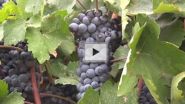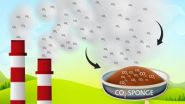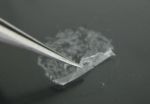(Press-News.org) SAN FRANCISCO, Aug. 10, 2014 — High-tech specks called quantum dots could bring brighter, more vibrant color to mass market TVs, tablets, phones and other displays. Today, a scientist will describe a new technology called 3M quantum dot enhancement film (QDEF) that efficiently makes liquid crystal display (LCD) screens more richly colored.
His talk will be one of nearly 12,000 presentations at the 248th National Meeting & Exposition of the American Chemical Society (ACS), the world's largest scientific society, taking place here through Thursday.
"Green grass just pops out at you from these displays," says Eric Nelson, Ph.D., who helped create the plastic films that hold the quantum dots in a screen. "We believe this is the most efficient way to get to a high-color display."
That's because quantum dot, or "QD," displays need less energy compared to other high-color options. QDs are superconducting crystals so small that 10,000 could fit across the width of a human hair.
Almost all electronics sold today, from TVs to smartphones, use LCDs. A typical LCD works by shining white light through a series of fliters that produce the colors the viewer sees. To achieve the best color, these filters need to be fairly dark. However, it takes a lot of energy to make the light bright enough for the viewer's eye. The other problem, says Nelson, who is at the 3M Company, is that "you always tend to leak a bit of green into red, and blue into green, and so forth. So instead of ending up with a very pure red, you end up with an orange-y color. It's difficult to get roses or apples to look very red on a conventional LCD."
Rather than filtering light, QDs change it into a different color. The dots — made for 3M by Nanosys, Inc. — produce specific colors of light based on how big they are. In 3M QDEF displays, the LCD's white backlight is replaced with a blue one, and a sheet of plastic embedded with QDs that produce red and green light is placed over it. The display combines these three colors to produce all the colors the viewer sees.
One drawback of the dots is that they break down quickly when exposed to water and oxygen in the air. To address this challenge, Nelson helped create the plastic sheathing that protects them. They sandwiched the QDs between two polymer films, with the QDs embedded in an epoxy glue. "The polymer/quantum dot sandwich looks like a piece of plastic film," says Nelson. Coatings on the film provide further protection and enhance the viewing experience.
Nelson also will describe the environmental advantages of the technology. Because the QDEF displays need less light, they consume less electricity and help device batteries last longer than other high-color solutions. He says 3M's tests have shown that the dots' heavy metals — many of which are already found in today's electronics — are entirely sealed inside the film. That means they won't leach out during the products' lifetime or as they languish in landfills if the displays aren't recycled.
3M hopes QDEF technology will compete well with more costly displays like those that use organic light-emitting diodes (OLEDs). Nelson explains that OLEDs produce similarly brilliant colors to the QDEF displays, but they use individual lights to make different colors. The drawback to OLEDs is that they are much more costly to manufacture.
Although QDEF displays are more expensive than conventional low-color LCDs, Nelson says the cost will come down as the technology becomes more widespread and as manufacturing costs come down with increased production scale. Several devices featuring QDEF are already on the market, and more are on the way.
INFORMATION:
A press conference on this topic will be held Monday, August 11, at 10:30 a.m. Pacific time in the Moscone Center, North Building. Reporters may report to Room 113 in person, or access live video of the event and ask questions at the ACS Ustream channel http://www.ustream.tv/channel/acslive.
The American Chemical Society is a nonprofit organization chartered by the U.S. Congress. With more than 161,000 members, ACS is the world's largest scientific society and a global leader in providing access to chemistry-related research through its multiple databases, peer-reviewed journals and scientific conferences. Its main offices are in Washington, D.C., and Columbus, Ohio.
To automatically receive news releases from the American Chemical Society, contact newsroom@acs.org.
Note to journalists: Please report that this research is being presented at a meeting of the American Chemical Society.
Follow us: Twitter | Facebook
Title
Quantum dot films in display technology
Abstract
This submission will describe the application of Quantum Dot Films in Liquid Crystal Displays (LCD). Quantum Dots (QD) are nanocrystals of semiconductor material that exhibit unique emission properties. Specifically, the excitons are confined with the QD, and therefore the size of the dot determines the energy level of the emission. In fluorescent applications, the frequency of emitted light increases as the size of the quantum dot decreases, allowing the emission to be highly tunable. Based on the tunability and the narrow emission spectra, QDs have been described for use in LCD's to improve the color gamut.
A color LCD is lit by conventional white LEDs that are color filtered to produce red, green, and blue pixels. However by switching to a blue-emitting LED, a portion of the blue light can be converted into green and red light by the quantum dots. This produces a white backlight for an LCD panel which can provide improved color gamut for the display.
One drawback of QDs is their susceptibility to oxidization and hydrolysis. To maintain their high fluorescence quantum yield, the QDs must be maintained in an air free environment. Therefore to make a commercial LCD application possible, a delivery format that maintains an air free environment and can be easily handled is required. This presentation will explore the application and the polymer properties required to bring this technology to commercial success.
The grass really is greener on TV and computer screens, thanks to quantum dots
2014-08-10
ELSE PRESS RELEASES FROM THIS DATE:
Pregnant women and fetuses exposed to antibacterial compounds face potential health risks
2014-08-10
SAN FRANCISCO, Aug. 10, 2014 — As the Food and Drug Administration (FDA) mulls over whether to rein in the use of common antibacterial compounds that are causing growing concern among environmental health experts, scientists are reporting today that many pregnant women and their fetuses are being exposed to these substances. They will present their work at the 248th National Meeting & Exposition of the American Chemical Society (ACS), the world's largest scientific society.
The meeting, which takes place here through Thursday, features nearly 12,000 presentations on a ...
Wine symposium explores everything you wanted to know about the mighty grape (video)
2014-08-10
San Francisco, Aug. 10, 2014 — Location. Location. Location. The popular real estate mantra also
turns out to be equally important for growing wine grapes in fields and storing bottles of the beverage at home or in restaurants, according to researchers.
Those are just two of the topics that will be covered in a symposium titled, "Advances in Wine Research," that will run today through Tuesday at the 248th National Meeting & Exposition of the American Chemical Society (ACS). The meeting features nearly 12,000 reports. A brand-new ACS video on the topics is available ...
Carbon dioxide 'sponge' could ease transition to cleaner energy
2014-08-10
SAN FRANCISCO, Aug. 10, 2014 — A sponge-like plastic that sops up the greenhouse gas carbon dioxide (CO2) might ease our transition away from polluting fossil fuels and toward new energy sources, such as hydrogen. The material — a relative of the plastics used in food containers — could play a role in President Obama's plan to cut CO2 emissions 30 percent by 2030, and could also be integrated into power plant smokestacks in the future.
The report on the material is one of nearly 12,000 presentations at the 248th National Meeting & Exposition of the American Chemical Society ...
On the frontiers of cyborg science
2014-08-10
SAN FRANCISCO, Aug. 10, 2014 — No longer just fantastical fodder for sci-fi buffs, cyborg technology is bringing us tangible progress toward real-life electronic skin, prosthetics and ultraflexible circuits. Now taking this human-machine concept to an unprecedented level, pioneering scientists are working on the seamless marriage between electronics and brain signaling with the potential to transform our understanding of how the brain works — and how to treat its most devastating diseases.
Their presentation is taking place at the 248th National Meeting & Exposition of ...
Like cling wrap, new biomaterial can coat tricky burn wounds and block out infection
2014-08-10
SAN FRANCISCO, Aug. 10, 2014 — Wrapping wound dressings around fingers and toes can be tricky, but for burn victims, guarding them against infection is critical. Today, scientists are reporting the development of novel, ultrathin coatings called nanosheets that can cling to the body's most difficult-to-protect contours and keep bacteria at bay.
The researchers are speaking about their materials, which they've tested on mice, at the 248th National Meeting & Exposition of the American Chemical Society (ACS), the world's largest scientific society.
The meeting features ...
Women who 'lean in' often soon leave engineering careers, study finds
2014-08-09
WASHINGTON –- Nearly 40 percent of women who earn engineering degrees quit the profession or never enter the field, and for those who leave, poor workplace climates and mistreatment by managers and co-workers are common reasons, according to research presented at the American Psychological Association's 122nd Annual Convention.
While women accounted for more than 20 percent of engineering school graduates over the past two decades, only 11 percent of practicing engineers are women, and only 9 percent of electronic and environmental engineers are, said Nadya Fouad, PhD, ...
Happier consumers can lead to healthier environment, research reveals
2014-08-09
WASHINGTON -- The pursuit of true happiness can lead people to lifestyles that will not only be satisfying but will be better for the environment, according to an overview of psychological research presented at the American Psychological Association's 122nd Annual Convention.
"For decades, consumerism has been on a collision course with the environment, with consumer appetites draining the planet of natural resources and accelerating global warming. One view is that we need to change consumption in order to save the planet," said Miriam Tatzel, PhD, of Empire State College. ...
Trauma before enlistment linked to high suicide rates among military personnel, veterans
2014-08-09
WASHINGTON -- High rates of suicide among military service members and veterans may be related to traumatic experiences they had before enlisting, making them more vulnerable to suicidal behavior when coping with combat and multiple deployments, according to the findings of several recent studies presented at the American Psychological Association's 122nd Annual Convention.
Experiencing child abuse, being sexually victimized by someone not in the service and exhibiting suicidal behavior before enlisting are significant risk factors for service members and veterans who ...
Regular marijuana use bad for teens' brains
2014-08-09
WASHINGTON –- Frequent marijuana use can have a significant negative effect on the brains of teenagers and young adults, including cognitive decline, poor attention and memory, and decreased IQ, according to psychologists discussing public health implications of marijuana legalization at the American Psychological Association's 122nd Annual Convention.
"It needs to be emphasized that regular cannabis use, which we consider once a week, is not safe and may result in addiction and neurocognitive damage, especially in youth," said Krista Lisdahl, PhD, director of the brain ...
Individual genotype influences effectiveness of HIV vaccine
2014-08-09
Almost 40 million people worldwide live with HIV/AIDS. Despite great effort, HIV-1 vaccine development has been challenging. A recent HIV vaccine trial, known as RV144, revealed that a combination of 2 vaccines protected some individuals from HIV infection. Individuals in the trial that made antibodies that bound to a specific region of the HIV envelope protein had a decreased risk of HIV infection. A new study in the Journal of Clinical Investigation reveals that an individual's genotype correlates with their ability to develop immunity to HIV in response to vaccination. ...



